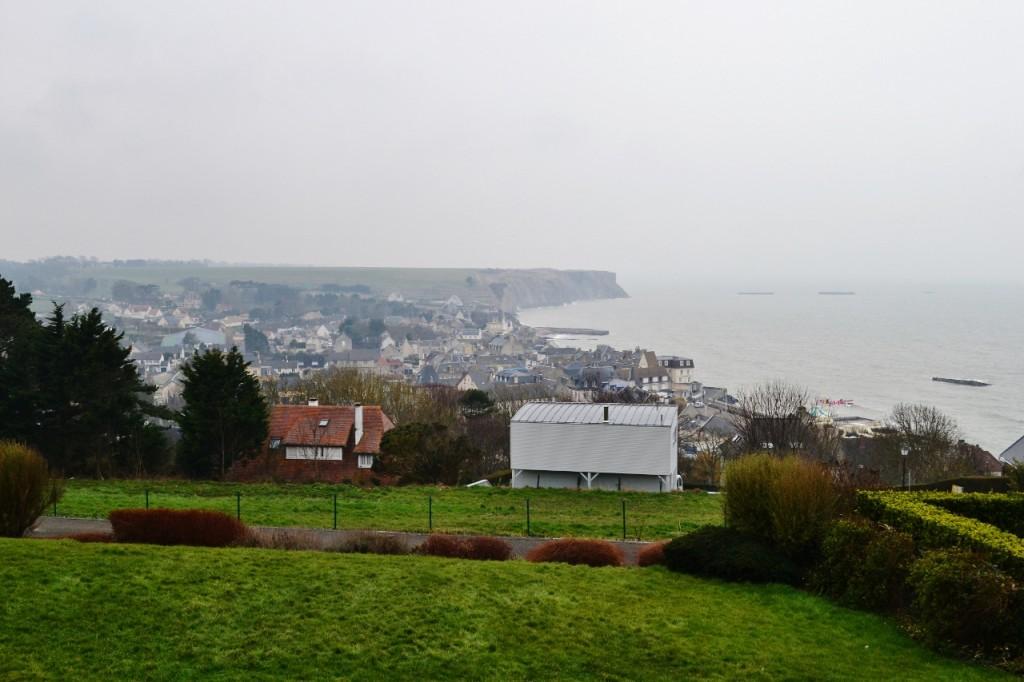Normandy, France
The view from the Cinema Circulaire, Arromanches 360 in Arromanches Les Bains. Photo courtesy of Manu Kondapi, Copyright © 2013 Manu Kondapi
September 20, 2013
It’s a 2 hour and 27 minute train ride from Paris’ St. Lazarus station to Caen, France. And from Caen to the Normandy Beaches is 26 kilometers by car. A number of travelers- especially those who visit with tour groups- miss this tribute to World War 2, this landmark that still resonates with the bravery and determination of the Allied troops as they stormed the French beaches on June 6th, 1944.
I visited the Normandy American Cemetery in Colleville-Sur-Mer on a Wednesday in March- the weather was nearly freezing and the sky was overcast, seeming to promise rain at any moment. I began my journey in the new visitor center, recently initiated by the American Battle Monuments Commission to better convey the courageous and inspiring stories of the 10000 casualties of the Battle of Normandy. The center puts the D-Day landings in a greater perspective with powerful exhibits and a remarkable movie about that historic day, accurately presenting the landings as one of the greatest military achievements in history.
The tour of the cemetery grounds began at the terrace with a view overlooking Omaha Beach, one of the five D-Day landing sites. Omaha faced the greatest adversity of the five with undesirable terrain and strong defensive forces; however, it was a crucial strategic measure to connect the five beaches. The crews faced difficulties in navigation and the hindrances meant for the Germans failed to activate properly, leaving the German defensive forces intact and able to inflict heavy casualties upon the US troops. Complicated beach obstacles delayed the troops’ advance and prevented them from effectively clearing the defended exits off the beach. Hours after the initial landing and the occupation of the Gold, Sword, Utah, and Juno Beaches, two small footholds were secured, which were exploited over the next few days to penetrate further inland and to achieve the original D-Day objectives.
Perhaps my favorite part of the visit was hearing the inspiring and hopeful stories of fallen soldiers and their families. One story that nearly brought me to tears concerned family loyalty, specifically Billy Harris and his wife’s 60 year search for him. At the age of 19, Harris received a letter from the army stating that her husband was missing; she consequently vowed to remain chaste and unmarried until she located him. Never did she receive a letter informing her of her husband’s death. In 2005, after 60 years of searching, she finally found him at his gravesite in Colleville-sur-Mer, Normandy, France at the cemetery. She now visits him every year and has shared that she is ready to pass on because she has found peace at last.
Only 25 minutes from Colleville-Sur-Mer is Arromanches les Bains, a quaint French village which is home to the Cinema Circulaire “Arromanches 360.” The Price of Freedom is projected in high definition on nine screens- the otherwise unpublished archive footages retrace the 100 days of the raging battle at Normandy. For twenty minutes, the viewers slip into the skin of a soldier and immerse themselves in the battle. Over 65,000 archived footage shots from the events of 1944 were collected and perfectly synchronized with picture and sound to create such an effect. I, myself, was rendered speechless.
If you get the chance to visit Paris, you must spend at least a day on the Normandy coast. So many choose to instead delve in the glamour and beauty that Paris offers and miss out on this poignant experience. Stay in Bayeux for the night- a small town with one of the best boulangeries I’ve eaten at- and make the drive to the American Cemetery the following day, followed by Pointe Du Hoc and Arromanches-les-Bains.
The entire Normandy coast resounds with the history of our past and our confidence in the future, and is an absolute must-see for any future tourist to France.
[portfolio_slideshow id=4092]









